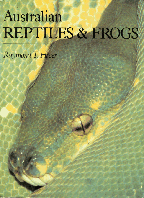 SAND GOANNA Varanus gouldii (Gray, 1838)
SAND GOANNA Varanus gouldii (Gray, 1838)
Several species are involved here. The Sand Goanna is also known as Gould's Monitor in the eastern states, Bungarra in north and western Australia, and the Racehorse Goanna in the South-west of Western Australia. The name Racehorse Goanna comes from the high speed at which it can run, and it is found in all but the very coldest parts of mainland Australia. These lizards range in adult size from 1 to 2 metres, and pattern and build vary from locality to locality. The largest specimens occur in the vicinty of the Gulf of Carpentaria, Queensland and the Northern Territory. juveniles are usually much brighter than the adult specimens in colour, particularly in coastal New South Wales, south-eastern Queensland and southwestern Western Australia, where juveniles have bright reddish markings. A few distinct 'forms' of this goanna are illustrated here.
This lizard is found in all types of habitat, but is most common in sandy types of area. This ground-dweller forages widely in search of its animal food, which includes smaller reptiles, frogs, birds, etc. It will often dig burrows under large boulders, logs and other ground cover under which it will shelter when not active.
When cornered adult specimens (particularly the northern inland form) will raise the front part of their body off the ground, in a kangaroo-like position and his, loudly.
Some Aboriginals who catch this lizard for food will throw the dead lizards on to a fire and cat them when the skin begins to peel. The best meat is on the base of the tail and tastes similar to chicken.
Male specimens commonly extrude their hemipenes when caught.
At the time this book was published in 1989, centralian animals were sometimes identified as the full species V. flavirufus, northern specimens as V. gouldii and the darker coastal animals as V. rosenbergi.
However the cat was thrown among the pigeons when Glen Storr redescribed the type species (gouldii) as V. panoptes. In 1992 Bohme published a paper proving that panoptes was not a valid name because it was a junior synonym of gouldii and that in theory should have been the end of the name.
However subsequent to this there was a series of corrupt deals which ultimately led to the ICZN violating its own written rules and guidelines to use its plenary powers in March 2000 to formally suppress the type species gouldii and renaming it panoptes. At the same time the centralian form, formerly known as flavirufus was also suppressed in favor of a new name 'gouldii'.
The above was from the book Australian Reptiles and Frogs by Raymond Hoser and now available on a fantastic CD-Rom along with a vast amount of other information, papers and the like on reptiles, frogs and other wildlife.